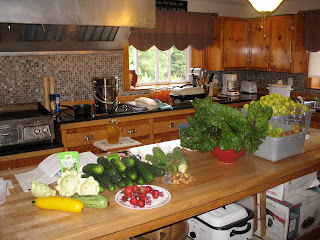
This photograph is a close-up of the hibiscus (rose of Sharon) blue satin. I planted it Fall 2008. It did very little during 2009. There were hardly any leaves on it, and it did not bloom. In fact, I was nearly convinced that it did not survive the winter. However, I left it in the ground, and it is doing wonderfully this year. So far, there have been several dozen blooms on it. It will eventually grow to be a bush that is about 8 feet tall. As it grows, I will transfer some of the perennials that are near it to other locations on the property so that the hibiscus will have plenty of room. This bush is very useful for late summer blooms. By the time it stops blooming, the blue and purple aster in the sun bed will be in full bloom.

In the naturalized bed, the red and maroon Jacob's Cline Monarda (bee balm) is nearing the end of its bloom cycle. However, the butterflies are still enjoying it immensely. Whenever, I look at this perennial, there are always dozens of butterflies on and around it. I highly recommend this perennial for a naturalized area where it has plenty of room to grow. My bee balm perennials started as little plants but are now taller than me. I have to continually divide them and give them to friends to prevent them from overtaking this flower bed.

In the friendship garden, the yellow rudbeckia (brown-eyed susans) are in full bloom while the red-orange and orange day lilies wind down their bloom cycle. This is my favorite time of the year for this perennial bed because, as previously noted, I just love the mix of red, orange and yellow that this combination of these day lilies and brown-eyed susans provides.

In the partial shade garden, the purple clematis are no longer blooming, but the rudbeckia goldsturm (brown-eyed susan) and yellow thread-leaved coreopsis (tickseed) are in full bloom. I just love both of these flowers because they are deer resistant, care free, insect resistant, and long blooming. They are equally at home in the perennial bed and in a naturalized setting, and they are a great choice for late summer color. These perennials are surrounded by large dark green and smaller yellow-green hostas.
 This is a close-up photo of the brown-eyed susan and coreopsis.
This is a close-up photo of the brown-eyed susan and coreopsis.
The lobelia (cardinal flower) that I planted this Spring is in full bloom. I love this perennial in the naturalized setting where it is usually red. I originally thought this purple variety would be perfect in this full shade spot to add height and interest and attract butterflies and hummingbirds. However, as you can see, it currently needs staking because the stalks were just laying on the ground, but the perennial appears to be healthy. I am going to research this issue because they should not need staking. Hopefully, I can figure out this issue by next year.
 Five hostas in the shade garden have become casualties to the deer. It happens to the best of us, and it does not actually harm the plant. It just looks ugly. This perennial bed is right up against the woods on the far side of the house. The deer can easily sneak in, have a meal, and sneak out before I even notice. Ken sprays an organic deer guard on the hostas for me, but when we have lots of rain, it washes off fairly quickly.
Five hostas in the shade garden have become casualties to the deer. It happens to the best of us, and it does not actually harm the plant. It just looks ugly. This perennial bed is right up against the woods on the far side of the house. The deer can easily sneak in, have a meal, and sneak out before I even notice. Ken sprays an organic deer guard on the hostas for me, but when we have lots of rain, it washes off fairly quickly.


















